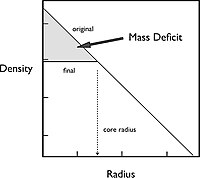Mass deficit

So, you know how everything is made up of tiny building blocks called atoms? Well, atoms are made up of even tinier things called protons, neutrons, and electrons.
Now, protons and neutrons are very important because they are what make up the nucleus of an atom (think of it like the center of an atom). But here’s the thing - protons and neutrons have a tiny bit of mass.
When scientists looked at the mass of an atom as a whole, they noticed something strange. The mass of the nucleus (the protons and neutrons) didn’t seem to equal the mass of the atom as a whole.
They realized that a tiny bit of mass was actually missing. This missing mass is what we call mass deficit. It’s like if you and your friend have a bag of ten candies, but when you count them there are only nine. One candy is missing! In the same way, mass deficit is like a tiny bit of mass that’s missing from the atom's total weight.
But where did this missing mass go? Well, scientists figured out that it’s actually turned into energy. You might remember from science class that energy cannot be created or destroyed, only transformed into something else.
So, when the tiny bit of mass goes missing, it’s actually transformed into energy, just like when you put a battery into a toy and it makes it go.
Overall, mass deficit is when a tiny bit of mass seems to go missing from the total weight of an atom, but it actually gets transformed into energy.
Now, protons and neutrons are very important because they are what make up the nucleus of an atom (think of it like the center of an atom). But here’s the thing - protons and neutrons have a tiny bit of mass.
When scientists looked at the mass of an atom as a whole, they noticed something strange. The mass of the nucleus (the protons and neutrons) didn’t seem to equal the mass of the atom as a whole.
They realized that a tiny bit of mass was actually missing. This missing mass is what we call mass deficit. It’s like if you and your friend have a bag of ten candies, but when you count them there are only nine. One candy is missing! In the same way, mass deficit is like a tiny bit of mass that’s missing from the atom's total weight.
But where did this missing mass go? Well, scientists figured out that it’s actually turned into energy. You might remember from science class that energy cannot be created or destroyed, only transformed into something else.
So, when the tiny bit of mass goes missing, it’s actually transformed into energy, just like when you put a battery into a toy and it makes it go.
Overall, mass deficit is when a tiny bit of mass seems to go missing from the total weight of an atom, but it actually gets transformed into energy.
